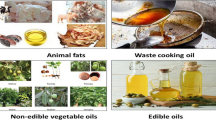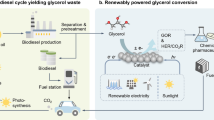Abstract
The activities of four immobilized lipases for glycerolysis of a commercially available fish oil (TG500) rich in eicosapentaenoic residues (>58%, w/w) have been characterized in solvent-free systems. The effects of the mole ratio of TG500 to glycerol and temperature have been investigated. The highest conversion was obtained at 60 °C with a Candida antarctica fraction B lipase (Chirazyme L-2) and a mole ratio of TG500 (based on fatty acid equivalents) to glycerol of 1.5 to 1.
Similar content being viewed by others
References
Arcos JA, Otero C (1996) Enzyme, medium, and reaction engineering to design a low-cost, selective production method for monoand dioleoylglycerols. J. Am. Oil Chem. Soc. 73: 673-682.
Berger M, Laumen KK, Schneider MP (1992) Enzymatic esterifi-cation of glycerol 1. Lipase-catalyzed synthesis of regioisomerically pure 1,3-sn-diacylglycerols. J. Am. Oil Chem. Soc. 69: 955-960.
Castillo E, Dossat V, Marty A, Stephane J, Combes D (1997) The role of silica gel in lipase-catalyzed esterification reactions of high polar substrates. J. Am. Oil Chem. Soc. 74: 77-85.
Castillo RE, Marty A, Combes D, Condoret JS (1994) Polar substrates for enzymatic reactions in supercritical CO2: how to overcome the solubility limitation. Biotechnol. Lett. 16: 169-174.
Fiechter A (1992) Biosurfactants: moving towards industrial applications. Trends Biotechnol. 10: 208-217.
Irimescu R, Furihata K, Hata K, Iwasaki Y, Yamane T (2001) Utilization of reaction medium-dependent regiospecificity of Candida antarctica lipase (Novozyme 435) for the synthesis of 1,3-dicapryloyl-2-docosahexaenoyl (or eicosapentaenoyl) glycerol. J. Am. Oil Chem. Soc. 78: 285-289.
Kamali R (1996) Historical perspective and potential use of n-3 fatty acids in therapy of cancer cachexia. Nutrition 12 (Suppl. 1): S2-S4.
Liu J, Bobik LE, Guzman-Harty M, Hastilow C (1993) Quantitative determination of monoglycerides and diglycerides by high-performance liquid chromatography and evaporative lightscattering detector. J. Am. Oil Chem. Soc. 70: 343-347.
Malaprade L (1928) Oxidation of some polyalcohols by periodic acid: applications. Compt. Rend. 186: 382-384.
Matsuo N (2001) Lipid Technol. 13: 129-133.
Otero C, Arcos JA, Berrendero MA, Torres C (2001) Emulsifiers from solid and liquid polyols: different strategies for obtaining optimum conversions and selectivities. J. Mol. Catal. B-Enz. 11: 883-892.
Rosu R, Iwasaki Y, Shimidzu N, Doisaki N, Yamane T (1998) Enzymatic synthesis of glycerides from DHA-enriched PUFA ethyl ester by glycerolysis under vacuum. J. Mol. Catal. B-Enz. 4: 191-198.
Wakelam MJO (1998) Diacylglycerol-when is it an intracellular messenger? Biochim. Biophys. Acta 1436: 117-126.
Author information
Authors and Affiliations
Rights and permissions
About this article
Cite this article
Torres, C., Lin, B. & Hill, C.G. Lipase-catalyzed glycerolysis of an oil rich in eicosapentaenoic acid residues. Biotechnology Letters 24, 667–673 (2002). https://doi.org/10.1023/A:1015298728683
Issue Date:
DOI: https://doi.org/10.1023/A:1015298728683




